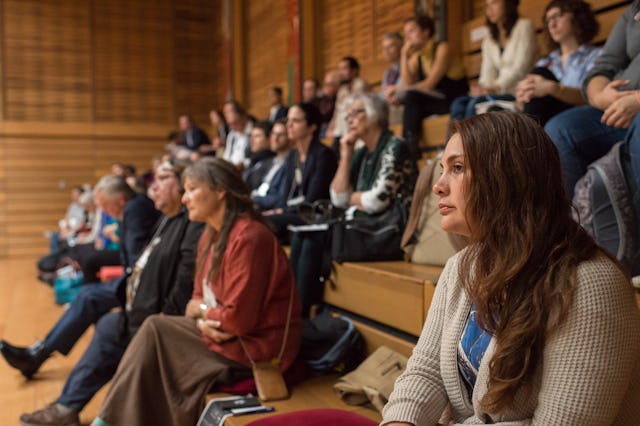Re-examining reconciliation
VICTORIA, Canada — Prof. Jeremy Webber, Dean of Law at the University of Victoria, looked out at a packed room. Government officials, Indigenous and religious leaders, students and academics, and members of the community had gathered for a symposium on reconciliation between the Indigenous and non-Indigenous people of the country.
The event sought to promote greater understanding about a fundamental question relating to reconciliation, raised by Prof. Webber in his opening remarks: “How should we approach engagement with religion and spirituality in the process of reconciliation?”
For the Baha’i community of Canada, this question is fundamental to a process of promoting justice and rebuilding relationships of trust, friendship, and cooperation between Indigenous and non-Indigenous peoples in Canada.
A dynamic, decades-long public conversation about the relationship between Indigenous and non-Indigenous people was energized by a report released in 2015 by the Truth and Reconciliation Commission on Indian Residential Schools (TRC), which investigated the impacts of Canada’s residential school system over many decades on indigenous children, families, and communities. This system of schooling was designed to assimilate Indigenous children into Canadian society by removing them from their families, cultures, languages, and spiritual traditions. Its effect was described by the TRC as “cultural genocide.”
The Baha’i community of Canada was an active participant in the work of the TRC. There are Baha’is among the survivors of the residential schools, and some testified before the Commission. At the national gatherings of the TRC held across the country, dozens of Baha’is volunteered to be of assistance to the participants.
The National Spiritual Assembly of the Baha’is of Canada made a submission and gift to the TRC in 2015, which was accompanied by a public presentation by Deloria Bighorn, Chairperson of the National Spiritual Assembly of the Baha’is of Canada. The Baha’i community also produced a short film, The Path Home, which it screened in Ottawa in association with the final national gathering.
It is within this broader context that the Baha’i Community of Canada worked with the University of Victoria Faculty of Law and the Centre for Studies in Religion and Society and the Pierre Elliott Trudeau Foundation to offer the recent symposium in March, which was titled “Rethinking the relationship between spirituality and reconciliation.”
“We are here to create a world in which the suffering of people is diminished and the nobility of people is enhanced. Our work is to re-create society with principles of justice and oneness.”
—Deloria Bighorn
The event brought together a number of leading thinkers, including many of Canada’s most prominent scholars of Indigenous law. It was held in the First Peoples House at the University of Victoria and coincided with the launch of the world’s first Indigenous law program, providing an occasion to examine how spirituality is conceptualized and applied within an evolving field of law as well as what implications this might hold for thinking more broadly about social change.
Speaking at the symposium on behalf of the Baha’i community, Mrs. Bighorn expressed her hopes for the gathering: “We are here to create a world in which the suffering of people is diminished and the nobility of people is enhanced. Our work is to re-create society with principles of justice and oneness.”
The symposium opened on 8 March with a public lecture in downtown Victoria, held to coincide with an annual week-long festival of research, art, and innovation. In addition to the 750 people in attendance, 5,000 people watched the opening online, as Prof. John Borrows and Prof. Val Napoleon spoke about the role of the sacred in Indigenous law. Borrows and Napoleon are leading a new initiative at the University of Victoria law school to offer a joint degree in Indigenous Law and Common Law.
On 9 March, 140 people gathered for a series of panel discussions on the past, present, and future of reconciliation. Those discussions were framed by a concept note prepared for the symposium, and participants grappled with the various ways in which colonization in Canada had disrupted the connection between Indigenous peoples and their spiritual and cultural heritage.
While the presentations addressed the tragic effects of colonization, occasions for hope and moments of intercultural interaction were also highlighted. One such moment was when Dr. Chelsea Horton described efforts by Indigenous and non-Indigenous Baha’is in Canada during the 1960s to stimulate a public conversation about “the right to an identity” by respecting and fostering Indigenous cultures.
The theme of social change was expanded upon by Dr. Roshan Danesh, a lawyer and Baha’i, who spoke on the first panel. Dr. Danesh commented, “There is a new dynamism and opportunity, as well as tension, as we learn how to talk and reflect on reconciliation.” He challenged those gathered to “question the architecture of our society…as we struggle to take the transformative actions that are needed.”
Douglas White, Director of the Centre for Pre-Confederation Treaties and Reconciliation at Vancouver Island University, touched on the kind of transformation that is needed in Canadian society. He noted that despite the importance of legal processes, they are “insufficient by themselves because of their hyper adversarial nature.”
“How do we inspire Canadians to be something different?” White—who is a member of the Snuneymuxw First Nation and a Baha’i—continued, asking if aspirations can transcend mere coexistence and tolerance. “I don’t want my children to be tolerated. I want my children to be loved by you, so that their well-being will be a concern to all Canadians.”
Prof. Borrows closed the proceedings by calling the participants to an active process of reflection on the day’s events, so that they could be more deeply understood. He said that this involves “engaging a greater mystery in our relationships to each other.”
The symposium was the latest in a series of ongoing contributions the Baha’i community has made to a national public discourse about reconciliation between Indigenous and non-Indigenous peoples in Canada.

